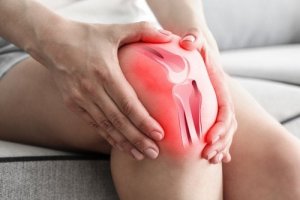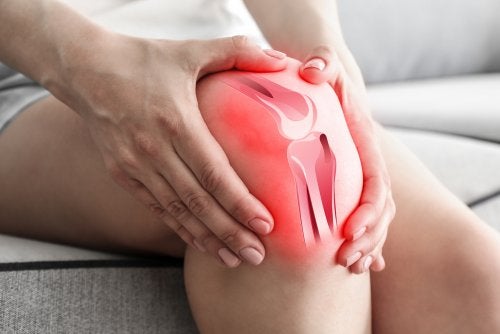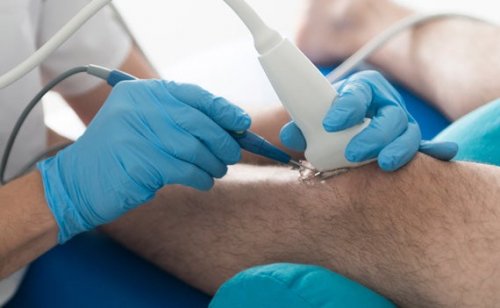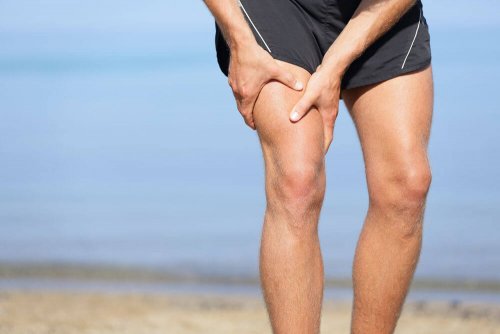Why Osteoarthritis Causes Knee Pain

Osteoarthritis, or arthrosis “by wear and tear,” is a systemic, degenerative disease that can affect any joint. It often manifests due to the wear of protective cartilage found at the ends of bones. When it occurs in the knees, osteoarthritis causes knee-pain.
Many different conditions and injuries may affect the knee. However, osteoarthritis is a chronic disease that affects it the most. In fact, one of the most common forms of this disease is known as osteoarthritis of the knee.
Its manifestation is common in middle-aged people and senior citizens. It’s also one of the main reasons for disability.
There are several available therapies and treatments to help cope with the pain. However, there’s no definitive cure for the underlying progressive process.
Why does osteoarthritis cause knee pain?

To understand why osteoarthritis causes knee pain, it’s important to address what it does to the joint.
While any body part can be affected, many cases result from the deterioration of the cartilage that lines the bones of the knee. Articular cartilage is soft and slippery. Their function is to protect and cushion the ends of the bones of the knee. When they wear out or become damaged, the joint loses its ability to flex and move normally.
Also, since this triggers an inflammatory process, it leads to episodes of chronic pain that worsen over time. Thus, if the person doesn’t follow the treatment to slow down its progression, over time, they won’t be able to move normally and will suffer from more severe symptoms.
Types of knee osteoarthritis
Osteoarthritis causes knee pain depending on the stage it’s in. Thus, when a patient is diagnosed, the specialist takes into account the three classifications of the condition.
A person can have the following types of knee osteoarthritis:
Mild knee osteoarthritis
Patients with this type of osteoarthritis only have discomfort after they exert themselves. The knee X-rays of these patients don’t show evident alterations.
Moderate knee osteoarthritis
In this case, some noticeable changes can be seen in a knee X-ray. Pain episodes manifest after standing for a long time or doing moderate exercise. Also, the symptoms appear and reappear several times a year.
Severe knee osteoarthritis
When it becomes severe, knee osteoarthritis causes prolonged knee pain, even after minor exertion. Typically, patients feel stiffness and pain in the first 20 minutes of the day, although the symptom decreases as time passes.
At this point, several joint effusion episodes with inflamed knee occur. Therefore, pain episodes are more frequent and can affect movement capacity. Obvious signs of cartilage deterioration can be seen in an X-ray in these cases.
The symptoms of knee osteoarthritis

The symptoms of osteoarthritis may vary according to how deteriorated the cartilage is. However, in general, its clinical manifestations are pain, swelling, and loss of function. This last symptom is the inability to move the knee.
Swelling, which is the reason why osteoarthritis causes knee pain, happens when there’s excess synovial fluid inside of the joint. Since the joint doesn’t support the affected limb as it should, it limits movement and reduces a person’s quality of life.
In short, the symptoms may include:
- Pain that worsens in the mornings and decreases after “warming up” the knee.
- Feeling of stiffness after periods of inactivity.
- Prolonged pain after bending the knees (for example, after sitting for long periods).
- Severe pain that worsens with movement.
Why is early diagnosis so important?

It’s essential to note that all types of osteoarthritis worsen over time. Thus, the faster a patient is diagnosed, the better the prognosis and treatment outcomes. The doctor may recommend a series of X-rays to confirm the condition.
These tests can detect the extent of cartilage damage and if the joint space that separates the bones of the knee has decreased.
Once the professional has detected the stage of osteoarthritis the patient is in, they may suggest:
- Lifestyle changes (a healthy diet and low-impact physical activity)
- Physiotherapy
- Weight loss (if the patient is overweight or obese)
- Painkillers and anti-inflammatory drugs
- Surgery (arthroscopy or joint replacement; only in severe cases)
In short, the reason why osteoarthritis causes knee pain is the inflammatory process that comes from articular cartilage wear. Since it’s a progressive disease, it’s essential to get diagnosed and treated as soon as possible.
All cited sources were thoroughly reviewed by our team to ensure their quality, reliability, currency, and validity. The bibliography of this article was considered reliable and of academic or scientific accuracy.
-
Escarpanter Buliés, J. C., Valdés Díaz, O., Sánchez Rauder, R., López Valdés, Y., & López García, C. (1997). Resultados terapéuticos en la osteoartritis de la rodilla con infiltraciones de ozono. Revista Cubana de Investigaciones Biomédicas, 16(2), 124-132.
-
López, A. A., Morote, C. C., & Lorenzo, Y. G. (2004). Tratamiento quirúrgico de la osteoartritis de rodilla. Rev Cubana Ortop Traumatol, 18(1), 53-9.
-
Solis Cartas, U., de Armas Hernandez, A., & Armando, B. C. (2014). Osteoartritis. Características sociodemográficas. Revista Cubana de Reumatología, 16(2), 97-103.
This text is provided for informational purposes only and does not replace consultation with a professional. If in doubt, consult your specialist.








